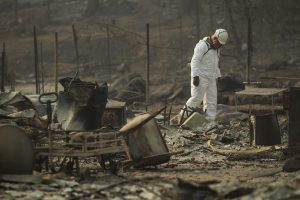The negative impacts of climate change on physical health are well-documented. However, physical health is not the only component of overall health – mental health is also an important factor in our well-being. Climate change can increase risks for short-term and long-term mental health conditions, including post-traumatic stress disorder, depression, anxiety, and sleep disorders in both adults and children. Understanding the direct and indirect impacts of climate change on mental health is the first step to building resilience and harnessing hope for a brighter future.

Mental Health Effects of Climate Disasters
The increase of global temperatures has exacerbated natural disasters such as wildfires, floods, and hurricanes, impacting both their severity and frequency. Natural disasters have acute and long-term effects on the communities that experience them. While the physical destruction of natural disasters is obvious, the mental toll can be just as severe.
 Researchers at the University of California published a study in 2021 that examined a sample of 725 Californians affected by the deadly 2018 Camp Fire and found significant increases in mental health disorders, especially PTSD and depression. The authors of this paper noted that “[u]nchecked climate change projected for the latter half of this century may severely impact the mental wellbeing of the global population.”
Researchers at the University of California published a study in 2021 that examined a sample of 725 Californians affected by the deadly 2018 Camp Fire and found significant increases in mental health disorders, especially PTSD and depression. The authors of this paper noted that “[u]nchecked climate change projected for the latter half of this century may severely impact the mental wellbeing of the global population.”
How Climate Disasters Affects Children’s Mental Health
Just like adults, children who experience climate-related disasters can show signs of anxiety, depression, and post-traumatic stress disorder. The link between climate change and children’s mental health varies. Experiencing a natural disaster in childhood is considered an Adverse Childhood Event (ACE), especially in situations involving the destruction of the child’s home or the death of a loved one. ACEs can increase risks for physical and mental health problems later in life.
For children who have directly experienced a climate-related disaster, a supportive adult in the child’s life is one of the best ways to combat negative effects of ACEs. The Harvard T.H. Chan School of Public Health’s Center for Climate, Health, and the Global Environment has a guide for parents on children’s mental health and climate change.
Eco-Anxiety Can Impact Us All
You don’t have to directly experience a climate-related disaster in order to feel the effects of climate change on mental health. Witnessing the realities of climate change, either first-hand or through the news, can evoke feelings of worry, helplessness, anger, and fear about the future.
Increasingly, the term “eco-anxiety” has been used to describe the fear response to the ongoing threats of climate change. An American Psychological Association (APA) survey conducted in 2020 found that 68% of adults surveyed reported experiencing “at least a little” eco-anxiety.
Children Experience Eco-Anxiety Too
Children and young people are considered particularly vulnerable to the effects of eco-anxiety. In a 2021 study published in The Lancet Planetary Health, researchers interviewed 10,000 people ages 16-25 in 10 countries about their climate anxiety. 59% reported being very or extremely worried and over 45% said their eco-anxiety negatively affected their daily life and ability to function.
Building Resilience: Climate Change and Managing Mental Health
 An important factor in mitigating negative mental health outcomes related to climate change is building resilience. Resilience is defined as “the process and outcome of successfully adapting to difficult or challenging life experiences.” Resilience empowers people to navigate stressful or uncertain situations like climate change with increased emotional stability and healthy coping mechanisms. Research has shown that while some people naturally have an increased capacity for resilience, it is a learned skill that everyone can develop. Developing resilience is especially important for children.
An important factor in mitigating negative mental health outcomes related to climate change is building resilience. Resilience is defined as “the process and outcome of successfully adapting to difficult or challenging life experiences.” Resilience empowers people to navigate stressful or uncertain situations like climate change with increased emotional stability and healthy coping mechanisms. Research has shown that while some people naturally have an increased capacity for resilience, it is a learned skill that everyone can develop. Developing resilience is especially important for children.
The APA has a guide for building resilience against climate change-related threats. Many of the important factors mentioned in the APA guide focus on fostering optimism and hope, cultivating self-regulation skills, and encouraging both interpersonal and community connections. With this in mind, it is important to include some bright spots when teaching students about climate-related issues.
Help Students Feel Hopeful in Spite of Climate Change
The link between mental health and our changing climate should not be ignored. Teaching young people about positive actions happening locally and around the world, and providing opportunities to share their ideas about global solutions, can help combat feelings of hopelessness and empower students to engage in fighting for a sustainable future.
Image credits: Boy looking out window (Image by Shlomaster from Pixabay); Member of the National Guard clearing debris after the 2018 Camp Fire (U.S. Air National Guard by California National Guard is licensed under CC BY 2.0 Deed); Wildflowers growing in harsh conditions (Beautiful Resilience by Western Arctic National Parklands is Public Domain)


